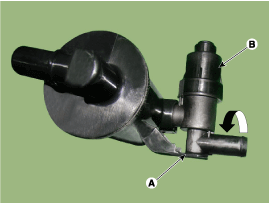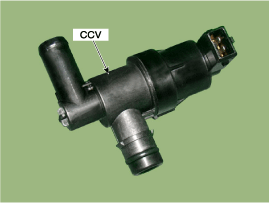Hyundai Genesis: Engine Control System / Canister Close Valve (CCV) Repair procedures
Hyundai Genesis (DH) 2013-2016 Service Manual / Engine Control / Fuel System / Engine Control System / Canister Close Valve (CCV) Repair procedures
| Inspection |
| 1. |
Turn the ignition switch OFF. |
| 2. |
Disconnect the CCV connector. |
| 3. |
Measure resistance between the CCV terminal 1 and 2. |
| 4. |
Check that the resistance is within the specification.
|
| 5. |
Disconnect the vapor hose connected with the canister from the CCV. |
| 6. |
Connect a vacuum pump to the nipple. |
| 7. |
Ground the CCV control line and apply battery voltage to the CCV power supply line. |
| 8. |
Apply vacuum and check the valve operation.
|
| Removal |
| 1. |
Turn the ignition switch OFF and disconnect the negative (-) battery cable. |
| 2. |
Remove the Fuel tank air filter.
(Refer to Emission Control System - "Fuel Tank Air Filter") |
| 3. |
Release the fixing hooks (A), and then separate the canister
close valve (B) from the fuel tank air filter (C) after rotating it in
the direction of the arrow in the figure.
|
| Installation |
|
| 1. |
To install, reverse the removal procedure.
|
 Canister Close Valve (CCV) Schematic Diagrams
Canister Close Valve (CCV) Schematic Diagrams
Schematic Diagrams
...
Other information:
Hyundai Genesis (DH) 2013-2016 Service Manual: Description and Operation
Warning Lamp Activation Warning Lamp Behavior after Ignition On As soon as the operating voltage is applied to the SRSCM ignition input, the SRSCM activates the warning lamp for a LED lamp check. The lamp shall turn on for 6 seconds during the initialization phase and turn off afterward. ...
Hyundai Genesis (DH) 2013-2016 Service Manual: In-car Sensor Description and Operation
Description An in-car air temperature sensor is located in the crash pad lower panel. The sensor contains a thermistor which measures the temperature of the cabin. The signal determined by the resistance value which changes in accordance with perceived inside temperature, is delivered to t ...
© 2013-2025 www.hgenesisdh.com




